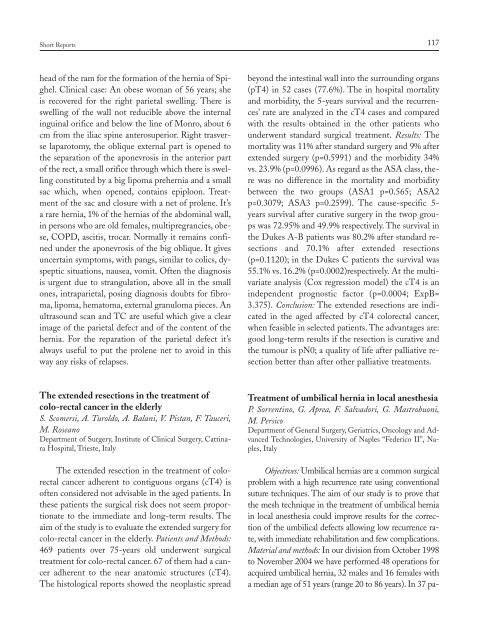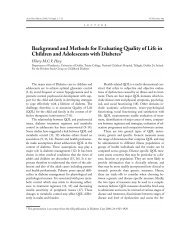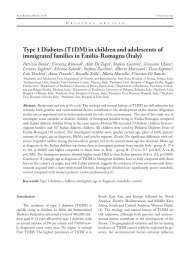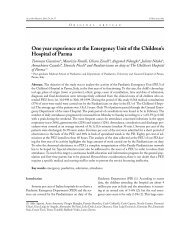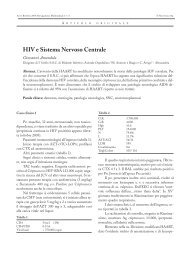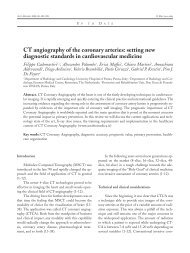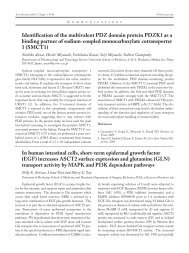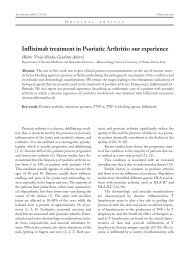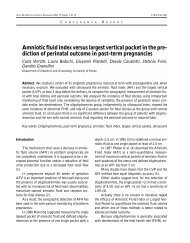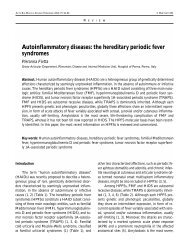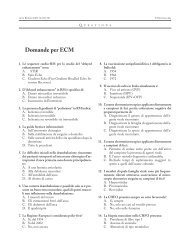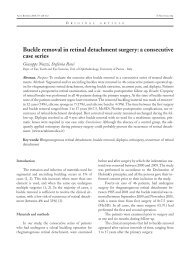Short reports+frontesp96-98 - Acta Bio Medica Atenei Parmensis
Short reports+frontesp96-98 - Acta Bio Medica Atenei Parmensis
Short reports+frontesp96-98 - Acta Bio Medica Atenei Parmensis
You also want an ePaper? Increase the reach of your titles
YUMPU automatically turns print PDFs into web optimized ePapers that Google loves.
<strong>Short</strong> Reports<br />
117<br />
head of the ram for the formation of the hernia of Spighel.<br />
Clinical case: An obese woman of 56 years; she<br />
is recovered for the right parietal swelling. There is<br />
swelling of the wall not reducible above the internal<br />
inguinal orifice and below the line of Monro, about 6<br />
cm from the iliac spine anterosuperior. Right trasverse<br />
laparotomy, the oblique external part is opened to<br />
the separation of the aponevrosis in the anterior part<br />
of the rect, a small orifice through which there is swelling<br />
constituted by a big lipoma prehernia and a small<br />
sac which, when opened, contains epiploon. Treatment<br />
of the sac and closure with a net of prolene. It’s<br />
a rare hernia, 1% of the hernias of the abdominal wall,<br />
in persons who are old females, multipregrancies, obese,<br />
COPD, ascitis, trocar. Normally it remains confined<br />
under the aponevrosis of the big oblique. It gives<br />
uncertain symptoms, with pangs, similar to colics, dyspeptic<br />
situations, nausea, vomit. Often the diagnosis<br />
is urgent due to strangulation, above all in the small<br />
ones, intraparietal, posing diagnosis doubts for fibroma,<br />
lipoma, hematoma, external granuloma pieces. An<br />
ultrasound scan and TC are useful which give a clear<br />
image of the parietal defect and of the content of the<br />
hernia. For the reparation of the parietal defect it’s<br />
always useful to put the prolene net to avoid in this<br />
way any risks of relapses.<br />
beyond the intestinal wall into the surrounding organs<br />
(pT4) in 52 cases (77.6%). The in hospital mortality<br />
and morbidity, the 5-years survival and the recurrences’<br />
rate are analyzed in the cT4 cases and compared<br />
with the results obtained in the other patients who<br />
underwent standard surgical treatment. Results: The<br />
mortality was 11% after standard surgery and 9% after<br />
extended surgery (p=0.5991) and the morbidity 34%<br />
vs. 23.9% (p=0.0996). As regard as the ASA class, there<br />
was no difference in the mortality and morbidity<br />
between the two groups (ASA1 p=0.565; ASA2<br />
p=0.3079; ASA3 p=0.2599). The cause-specific 5-<br />
years survival after curative surgery in the twop groups<br />
was 72.95% and 49.9% respectively. The survival in<br />
the Dukes A-B patients was 80.2% after standard resections<br />
and 70.1% after extended resections<br />
(p=0.1120); in the Dukes C patients the survival was<br />
55.1% vs. 16.2% (p=0.0002)respectively. At the multivariate<br />
analysis (Cox regression model) the cT4 is an<br />
independent prognostic factor (p=0.0004; ExpB=<br />
3.375). Conclusion: The extended resections are indicated<br />
in the aged affected by cT4 colorectal cancer,<br />
when feasible in selected patients. The advantages are:<br />
good long-term results if the resection is curative and<br />
the tumour is pN0; a quality of life after palliative resection<br />
better than after other palliative treatments.<br />
The extended resections in the treatment of<br />
colo-rectal cancer in the elderly<br />
S. Scomersi, A. Turoldo, A. Balani, V. Pistan, F. Tauceri,<br />
M. Roseano<br />
Department of Surgery, Institute of Clinical Surgery, Cattinara<br />
Hospital, Trieste, Italy<br />
The extended resection in the treatment of colorectal<br />
cancer adherent to contiguous organs (cT4) is<br />
often considered not advisable in the aged patients. In<br />
these patients the surgical risk does not seem proportionate<br />
to the immediate and long-term results. The<br />
aim of the study is to evaluate the extended surgery for<br />
colo-rectal cancer in the elderly. Patients and Methods:<br />
469 patients over 75-years old underwent surgical<br />
treatment for colo-rectal cancer. 67 of them had a cancer<br />
adherent to the near anatomic structures (cT4).<br />
The histological reports showed the neoplastic spread<br />
Treatment of umbilical hernia in local anesthesia<br />
P. Sorrentino, G. Aprea, F. Salvadori, G. Mastrobuoni,<br />
M. Persico<br />
Department of General Surgery, Geriatrics, Oncology and Advanced<br />
Technologies, University of Naples “Federico II”, Naples,<br />
Italy<br />
Objectives: Umbilical hernias are a common surgical<br />
problem with a high recurrence rate using conventional<br />
suture techniques. The aim of our study is to prove that<br />
the mesh technique in the treatment of umbilical hernia<br />
in local anesthesia could improve results for the correction<br />
of the umbilical defects allowing low recurrence rate,<br />
with immediate rehabilitation and few complications.<br />
Material and methods: In our division from October 19<strong>98</strong><br />
to November 2004 we have performed 48 operations for<br />
acquired umbilical hernia, 32 males and 16 females with<br />
a median age of 51 years (range 20 to 86 years). In 37 pa-


